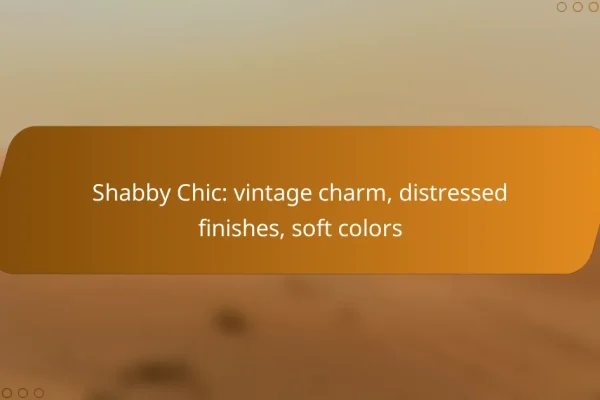What are the most popular home decor styles?
The most popular home decor styles include Modern, Bohemian, Industrial, Farmhouse, and Scandinavian. Each style has distinct characteristics and elements that cater to different tastes and preferences, making it essential to understand their unique features when decorating your home.
Modern style
Modern style emphasizes simplicity and functionality, often featuring clean lines and a neutral color palette. This decor style typically incorporates materials like glass, metal, and wood, creating a sleek and uncluttered look.
To achieve a modern aesthetic, focus on minimalistic furniture and decor items. Avoid excessive ornamentation and choose pieces that serve a purpose, ensuring that your space feels open and airy.
Bohemian style
Bohemian style is characterized by its eclectic mix of colors, patterns, and textures, reflecting a carefree and artistic vibe. This style often includes vintage furniture, handmade items, and global influences, creating a warm and inviting atmosphere.
To embrace Bohemian decor, layer textiles such as rugs and cushions, and incorporate plants for a natural touch. Don’t be afraid to mix and match different styles, as the essence of Bohemian decor lies in its individuality and personal expression.
Industrial style
Industrial style draws inspiration from warehouses and factories, showcasing raw materials and an unfinished look. Common elements include exposed brick, metal fixtures, and reclaimed wood, creating a rugged yet stylish environment.
To achieve an industrial feel, consider using large furniture pieces with a vintage or distressed finish. Open spaces with high ceilings and large windows can enhance this style, allowing natural light to highlight the unique features of your decor.
Farmhouse style
Farmhouse style combines rustic charm with modern comfort, often featuring warm colors, natural materials, and vintage accents. This style emphasizes a cozy, lived-in feel, making it perfect for creating a welcoming home.
Incorporate elements like shiplap walls, wooden beams, and antique furniture to achieve a farmhouse look. Accessorize with soft textiles and handmade decor to add warmth and character to your space.
Scandinavian style
Scandinavian style is known for its minimalism and functionality, focusing on simplicity, light colors, and natural materials. This decor style often features clean lines and a clutter-free environment, promoting a sense of calm and order.
To create a Scandinavian-inspired space, use a neutral color palette with pops of color through accessories. Incorporate natural elements like wood and plants, and choose furniture that balances aesthetics with practicality for a harmonious living space.
How to choose a home decor style?
Choosing a home decor style involves identifying your personal preferences, understanding the functionality of your space, and evaluating your existing furniture. This process ensures that your decor reflects your taste while serving practical needs.
Assess personal taste
Start by exploring various decor styles such as modern, rustic, or eclectic to determine what resonates with you. Consider creating a mood board with images, colors, and textures that appeal to you. This visual representation can help clarify your aesthetic preferences.
It’s also beneficial to think about the emotions you want your space to evoke. Do you prefer a calming atmosphere or a vibrant one? Identifying these feelings can guide your choices in colors and furnishings.
Consider space functionality
Evaluate how you use each room to ensure your decor style complements its purpose. For example, a cozy reading nook may benefit from warm colors and soft textures, while a home office might require a more organized and streamlined look.
Think about the flow of movement within the space. Ensure that your chosen decor style allows for easy navigation and accessibility, especially in high-traffic areas. This consideration can significantly enhance the overall functionality of your home.
Evaluate existing furniture
Take stock of your current furniture and decor items to see what can be integrated into your new style. This not only saves money but also helps maintain a sense of continuity in your home. Consider whether your existing pieces can be upcycled or reupholstered to fit your desired aesthetic.
When selecting a decor style, aim for a cohesive look that harmonizes with your current furnishings. If you have a mix of styles, choose a unifying element, such as color or material, to create a balanced appearance throughout your home.
What are the key characteristics of modern home decor?
Modern home decor is defined by its emphasis on simplicity, functionality, and a clean aesthetic. Key characteristics include sleek lines, a neutral color palette, and a minimalist approach that together create a harmonious living space.
Sleek lines
Sleek lines are a hallmark of modern home decor, emphasizing smooth, straight edges and geometric shapes. Furniture and architectural elements often feature streamlined designs that contribute to an uncluttered look. For example, a low-profile sofa with straight arms or a dining table with sharp angles exemplifies this characteristic.
When selecting pieces, focus on items that avoid excessive ornamentation. This approach not only enhances visual appeal but also promotes a sense of spaciousness in smaller areas.
Neutral color palette
A neutral color palette is essential in modern home decor, typically featuring shades like whites, grays, beiges, and blacks. These colors create a calm and cohesive environment, allowing for flexibility in accent colors and furnishings. For instance, a soft gray wall can serve as a perfect backdrop for vibrant artwork or colorful cushions.
To maintain balance, consider using varying textures within the neutral scheme. Mixing materials such as wood, metal, and fabric can add depth and interest without overwhelming the space.
Minimalist approach
The minimalist approach in modern decor focuses on ‘less is more’, prioritizing essential items and eliminating excess. This style encourages thoughtful selection of decor and furniture, ensuring that each piece serves a purpose or adds value to the space. For example, a single statement light fixture can replace multiple smaller lights, creating a focal point without clutter.
To adopt a minimalist approach, regularly assess your belongings and remove items that do not contribute to your desired aesthetic. Aim for a curated collection of decor that reflects your personality while maintaining the clean lines and open spaces characteristic of modern design.
How does farmhouse decor differ from industrial decor?
Farmhouse decor emphasizes warmth and comfort with rustic charm, while industrial decor focuses on raw, unfinished materials and a more urban aesthetic. The key difference lies in the use of natural elements in farmhouse style versus the sleek, metallic finishes commonly found in industrial design.
Warm, rustic elements in farmhouse
Farmhouse decor is characterized by its use of warm, inviting materials such as wood, stone, and soft textiles. Common features include reclaimed wood furniture, vintage accessories, and neutral color palettes that evoke a sense of coziness. Elements like shiplap walls and farmhouse sinks further enhance this style’s rustic appeal.
To achieve a farmhouse look, consider incorporating items like distressed wood tables, woven baskets, and soft, patterned throw pillows. These elements create a lived-in feel that is both functional and aesthetically pleasing.
Raw materials in industrial
Industrial decor embraces raw materials such as metal, concrete, and exposed brick, creating a stark and edgy atmosphere. This style often features open spaces with high ceilings and large windows, allowing natural light to accentuate the rugged textures. Furniture tends to be minimalist, with a focus on functionality.
To incorporate industrial elements into your home, look for pieces like metal shelving units, concrete countertops, and leather sofas. Mixing these materials can create a striking contrast, making the space feel modern yet grounded.
What are the best decor items for a Scandinavian style?
The best decor items for a Scandinavian style emphasize simplicity, functionality, and natural elements. Key items include light wood furniture, textured textiles, and functional accessories that create a warm and inviting atmosphere.
Light wood furniture
Light wood furniture is a hallmark of Scandinavian design, often featuring materials like pine, birch, or ash. These woods not only brighten up spaces but also add a touch of nature indoors. Look for pieces with clean lines and minimal ornamentation to maintain a sleek aesthetic.
When selecting light wood furniture, consider multifunctional items such as a coffee table with storage or a dining table that can extend for gatherings. This approach maximizes space and utility, aligning with the Scandinavian principle of practicality.
Textured textiles
Textured textiles play a crucial role in adding warmth and comfort to Scandinavian interiors. Fabrics like wool, linen, and cotton are commonly used for throws, cushions, and rugs. These materials provide tactile contrast against the smooth surfaces of wood furniture.
Incorporate a variety of textures by mixing knitted blankets with soft cushions or a plush area rug. This layering creates visual interest while maintaining the cozy, inviting feel characteristic of Scandinavian decor.
Functional accessories
Functional accessories are essential in Scandinavian design, emphasizing utility without sacrificing style. Items like stylish storage baskets, minimalist lighting fixtures, and simple wall art enhance both aesthetics and practicality. Choose accessories that serve a purpose while contributing to the overall design theme.
For example, opt for pendant lights that provide ample illumination while acting as a statement piece. Additionally, consider using decorative trays or organizers to keep spaces tidy, reflecting the Scandinavian value of orderliness.
How to mix different home decor styles?
Mixing different home decor styles involves blending elements from various aesthetics to create a cohesive look. Focus on maintaining a balance between contrasting styles through color, texture, and furniture choices.
Identify common color schemes
Establishing a common color scheme is crucial when mixing decor styles. Choose a palette that includes a few primary colors and complementary shades to unify the different elements in your space.
For instance, if you are combining modern and rustic styles, consider using neutral tones like beige or gray as a base, accented with earthy colors such as deep greens or browns. This approach can help create harmony between sleek furniture and natural materials.
To simplify the process, create a mood board with swatches of your chosen colors. This visual guide can help ensure that all decor items work well together, making it easier to select pieces that fit your vision.















